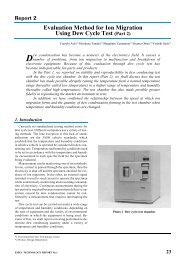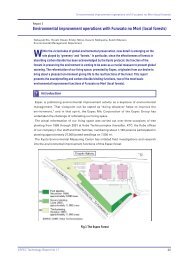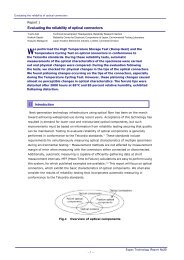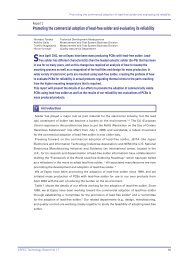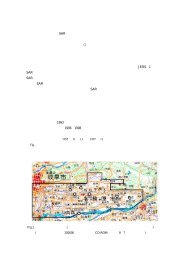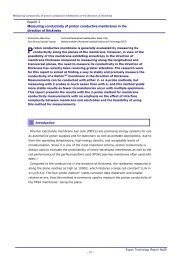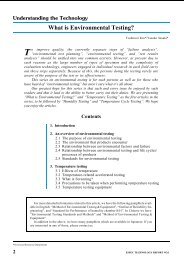download
download
download
Create successful ePaper yourself
Turn your PDF publications into a flip-book with our unique Google optimized e-Paper software.
(1) Pressure Cooker Test (PCT)<br />
Test chamber consists of a pressure vessel containing<br />
a water heater to create a 100%RH (saturated) atmosphere.<br />
Because the atmosphere is at 100%RH, dew condensation<br />
readily forms on the surface of the test<br />
specimens and on the inside walls of the test chamber.<br />
Also, in the chamber there is a risk of dew condensation<br />
(water droplets, min. 100C°!) dripping from the ceiling<br />
onto the specimens. Because of that, preventive measures<br />
are usually taken such as erecting drip protection<br />
hoods, but it is difficult to assure complete protection.<br />
Likewise, during the normal ramp-up of temperature<br />
and humidity, the temperature of the specimens rises<br />
more slowly than the temperature of the surrounding<br />
steam, so dew condensation on the surface of the specimens<br />
can’t be avoided. In any case, failures that differ<br />
from failures occurring in the field can be caused by the<br />
penetration of a large quantity of dew condensation.<br />
Handle<br />
Door<br />
Thermal insulation<br />
Pressure chamber heater<br />
Specimen<br />
Specimen shelf<br />
Humidifying water<br />
Thermal insulation<br />
(2) Unsaturated Pressure Cooker Test (USPCT)<br />
The Unsaturated Pressure Cooker was created to<br />
compensate for the shortcomings of the Pressure<br />
Cooker. The air temperature (dry bulb temperature) and<br />
water temperature are individually controlled inside the<br />
test chamber. By making it possible to control humidity<br />
at less than 100%RH, both dew condensation on the surface<br />
of the specimens as well as dripping onto the specimens<br />
are prevented.<br />
Recently, humidity is also controlled after the test to<br />
prevent specimens from drying out, and the most suitable<br />
test chamber is a chamber that avoids sudden<br />
changes in the test environment.<br />
Heater<br />
Table 3 A comparion of the Pressure Cooker and the Unsaturated Pressure Cooker<br />
Pressure Cooker Unsaturated Pressure Cooker<br />
· Test chamber simple and economical<br />
· Strong effects of dew condensation<br />
· Test chamber complicated and expensive<br />
· Poor correlation to failure modes in the field · Good correlation to failure modes in the field<br />
· Poor test reproducibility · Good test reproducibility<br />
· Difficult to apply bias · Easy to apply bias<br />
Fan<br />
Motor<br />
Fig.2 TABAI ESPEC’s Unsaturated Pressure Cooker<br />
Air exhaust<br />
port<br />
Humidifying heater<br />
Kiyoshi Takahisa/Shigeharu Yamamoto/Yoshihumi Shibata/Terunori Saeki/Hideo Iwama:<br />
From the “Reliability Test of Device and Components” (1992) Union of Japanese Scientists and Engineers<br />
6 ESPEC TECHNOLOGY REPORT NO.2



